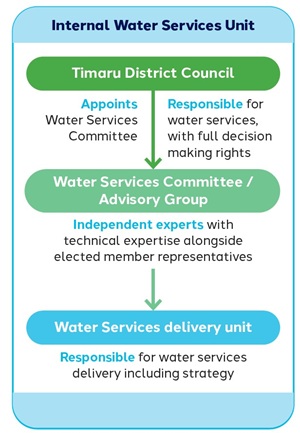 Under this option, we would continue to manage and deliver water services on our own, without partnering with other councils. We would be fully responsible for all day-to-day operations, maintenance, planning for future water needs, andrepaying any water-related debt.
Under this option, we would continue to manage and deliver water services on our own, without partnering with other councils. We would be fully responsible for all day-to-day operations, maintenance, planning for future water needs, andrepaying any water-related debt.
To help meet new government requirements, we would probably set up a dedicated water services delivery unit within the Council. We could share certain services with neighbouring councils or contract some operations to an external water services organisation.
However, that would not provide the same cost savings as being part of a joint water services organisation.It would be governed in line with the chart on the right.
Estimated costs
this is what ratepayers could expect to pay on average for water (drinking water, stormwater, wastewater) under the proposed option.
| Advantages | Disadvantages |
|---|
 Local decision-making Our Council, which is familiar with local conditions, would decide on Local decision-making Our Council, which is familiar with local conditions, would decide on
services and investments.
 Seamless integration Water services can be easily coordinated with our other responsibilities (such as district planning and transport). Seamless integration Water services can be easily coordinated with our other responsibilities (such as district planning and transport).
 Community accountability Communication with our community would continue to be straightforward, with us engaging directly with residents on water issues. Community accountability Communication with our community would continue to be straightforward, with us engaging directly with residents on water issues.
 Familiar structure Day-to-day operations would continue largely as they are now, which can help minimise transition costs and confusion. Familiar structure Day-to-day operations would continue largely as they are now, which can help minimise transition costs and confusion.
|  Highest Cost Option This option would probably be more expensive than if we joined a water services organisation – potentially costing customers an extra $230 a year more. Highest Cost Option This option would probably be more expensive than if we joined a water services organisation – potentially costing customers an extra $230 a year more.
 Longer-term challenges need to be funded We would need to fund major water infrastructure investment over the next 15 to 30 years, and those costs are likely to become more expensive over time. Council debt is limited to 2.8 times its income, so substantial borrowing for water limits our ability to invest in other important areas like roads, parks, and playgrounds. Longer-term challenges need to be funded We would need to fund major water infrastructure investment over the next 15 to 30 years, and those costs are likely to become more expensive over time. Council debt is limited to 2.8 times its income, so substantial borrowing for water limits our ability to invest in other important areas like roads, parks, and playgrounds.
 Increasing requirements We would need to meet tougher government regulations on our own, and this could lead to higher rates or more borrowing. Increasing requirements We would need to meet tougher government regulations on our own, and this could lead to higher rates or more borrowing.
 Limited opportunity for efficiencies We wouldn’t benefit from economies of scale that might come from partnering with other councils, potentially increasing our long-term operating costs. Limited opportunity for efficiencies We wouldn’t benefit from economies of scale that might come from partnering with other councils, potentially increasing our long-term operating costs.
 Competition for staff and contractors Competition for staff and contractors
|
Last updated: 15 May 2025
 Under this option, we would continue to manage and deliver water services on our own, without partnering with other councils. We would be fully responsible for all day-to-day operations, maintenance, planning for future water needs, andrepaying any water-related debt.
Under this option, we would continue to manage and deliver water services on our own, without partnering with other councils. We would be fully responsible for all day-to-day operations, maintenance, planning for future water needs, andrepaying any water-related debt.